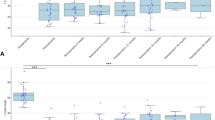Abstract
Study design
Retrospective study.
Objectives
The purpose of this study was to investigate sacral table angle (STA) values in early-stage spondylolysis.
Summary of background data
Several studies suggested that the STA of patients with L5 spondylolysis or spondylolisthesis was significantly lower than that of healthy controls. Separation of the pars interarticularis creates shear stress between the upper sacral end plate and L5 vertebra. This was considered the cause of low STA in patients with spondylolysis or spondylolisthesis. However, if a low STA value is obtained in the early stage of L5 spondylolysis, it suggests that low STA does not result in the remodeling of the sacral end plate.
Methods
Patients with L5 spondylolysis and those with low back pain without pars defect were retrospectively identified from a hospital database in 2014–2016. Pars defect of the spondylolysis was classified into three categories based on CT and MRI results: early, progressive, or terminal stage. The STA difference between groups was calculated using one-way analysis of variance and Scheffe F test, which were used for post hoc testing.
Results
A total of 84 cases of L5 spondylolysis and 70 cases of low back pain were identified. No significant difference was found between the STAs of the early- or progressive-stage spondylolysis and the terminal-stage L5 spondylolysis and low back pain patients. The STA of the terminal-stage L5 spondylolysis was significantly lower than that of low back pain patients.
Conclusions
In conclusion, patients with early- or progressive-stage spondylolysis do not have low STA. Low STA is seen only in patients with terminal-stage spondylolysis, suggesting that low STA is associated with remodeling changes in response to shear force after onset of spondylolysis. STA value might not important as a prognostic parameter about development of the spondylolysis.
Level of evidence
Level IV.



Similar content being viewed by others
References
Wiltse LL, Newman PH, Macnab I (1976) Classification of spondylolysis and spondylolisthesis. Clin Orthop Relat Res 117:23–29
Sakai T, Sairyo K, Takao S et al (2009) Incidence of lumbar spondylolysis in the general population in Japan based on multidetector computed tomography scans from two thousand subjects. Spine (Phila Pa 1976) 34:2346–2350
Goda Y, Sakai T, Sakamaki T et al (2014) Analysis of MRI signal changes in the adjacent pedicle of adolescent patients with fresh lumbar spondylolysis. Eur Spine J 23:1892–1895
Troup JD (1976) Mechanical factors in spondylolisthesis and spondylolysis. Clin Orthop Relat Res 117:59–67
Wang Z, Parent S, Mac-Thiong JM et al (2008) Influence of sacral morphology in developmental spondylolisthesis. Spine (Phila Pa 1976) 33:2185–2191
Whitesides TE Jr., Horton WC, Hutton WC et al (2005) Spondylolytic spondylolisthesis: a study of pelvic and lumbosacral parameters of possible etiologic effect in two genetically and geographically distinct groups with high occurrence. Spine (Phila Pa 1976) 30:S12–21
Inoue H, Ohmori K, Miyasaka K (2002) Radiographic classification of L5 isthmic spondylolisthesis as adolescent or adult vertebral slip. Spine (Phila Pa 1976) 27:831–838
Wang Z, Mac-Thiong JM, Parent S et al (2014) The relevance of sacral and sacro-pelvic morphology in developmental lumbosacral spondylolisthesis: are they equally important? Eur Spine J 23:157–162
Tallarico RA, Fredrickson BE, Whitesides TE Jr et al (2015) The association of sacral table angle measurements with spondylolytic and spondylolisthetic defects at the lumbosacral articulation: a radiographic analysis. Spine Deform 3:372–379
Fujii K, Katoh S, Sairyo K et al (2004) Union of defects in the pars interarticularis of the lumbar spine in children and adolescents. The radiological outcome after conservative treatment. J Bone Jt Surg Br 86:225–231
Morita T, Ikata T, Katoh S et al (1995) Lumbar spondylolysis in children and adolescents. J Bone Jt Surg Br 77:620–625
Sairyo K, Katoh S, Takata Y et al (2006) MRI signal changes of the pedicle as an indicator for early diagnosis of spondylolysis in children and adolescents: a clinical and biomechanical study. Spine 31:206–211
Funding
This research received no specific grant from any funding agency in the public, commercial, or not-for-profit sectors.
Author information
Authors and Affiliations
Corresponding author
Ethics declarations
Conflict of interest
KS (none), NI (none), MK (none).
IRB approval
The present study was approved by the Ethics Committee of the Obihiro Kyokai Hospital.
Additional information
Publisher’s Note
Springer Nature remains neutral with regard to jurisdictional claims in published maps and institutional affiliations.
Rights and permissions
About this article
Cite this article
Sugawara, K., Iesato, N. & Katayose, M. Comparison of the sacral table angles by progression stage of lumbar spondylolysis. Spine Deform 8, 123–127 (2020). https://doi.org/10.1007/s43390-020-00043-2
Received:
Accepted:
Published:
Issue Date:
DOI: https://doi.org/10.1007/s43390-020-00043-2




